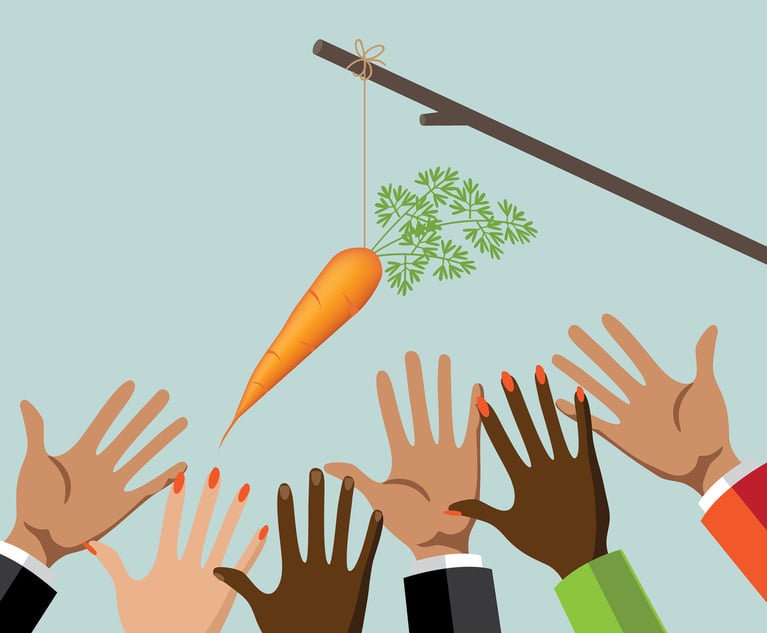The Big Fail: Why Bar Pass Rates Have Sunk to Record Lows
In this first installment of The Big Fail, a series focused on the high percentage of law graduates failing the bar and the impact on law schools and the legal profession, Law.com examines how far rates have dropped in recent years and the reasons for the decline.
April 14, 2019 at 05:00 PM
7 minute read
 Students taking a simulated multistate bar examination at the Jacob J. Javits Convention Center in New York City.
Students taking a simulated multistate bar examination at the Jacob J. Javits Convention Center in New York City.
Law Dean Thomas Geu didn't worry too much in 2014 when the percentage of J.D. graduates at his school who passed the July bar exam on the first try dropped by about 20 percent.
The pass rate at the University of South Dakota, which he'd led since 2011, fluctuated from time to time, so the decrease to 70 percent seemed like a temporary blip that would quickly correct itself.
But Geu realized he had a serious problem on his hands the following year, when that first-time South Dakota pass rate dropped another 20 percentage points, landing in the 50s. He found himself among scores of law deans across the country suddenly grappling with significant drops in bar pass rates, even when he didn't fully understand why they had fallen in the first place. The rate at his school bottomed out on the July 2017 exam, when just 46 percent passed the exam on their first attempt—roughly half the rate from four years earlier.
“From a dean's standpoint, there is no greater tragedy than someone coming to law school—wanting to practice law—and not passing the bar,” he said.
South Dakota is hardly the only law school struggling to bring up its bar pass rates. Pass rates in many of the country's largest jurisdictions have plummeted over the past five years, arguably replacing shrinking enrollment as legal education's single biggest challenge.
In the first in a series about the high percentage of law graduates failing the bar and the impact on law schools and the legal profession, Law.com examines how far rates have dropped in recent years and the reasons for the decline.
 The falloff has been national in scope. The average score on the Multistate Bar Exam—the multiple choice portion of the test—sank to a 34-year low on the July 2018 administration, according to the National Conference of Bar Examiners.
The falloff has been national in scope. The average score on the Multistate Bar Exam—the multiple choice portion of the test—sank to a 34-year low on the July 2018 administration, according to the National Conference of Bar Examiners.
In California, the overall pass rate fell from 56 percent in July 2013 to 41 percent last July. Texas' pass rate declined from 81 percent to 65 percent over that time period, while New York's fell from 69 percent to 63 percent. Florida's July 2018 pass rate was 67 percent—10 percentage points lower than five years earlier, while Pennsylvania's July pass rate was 6 percentage points lower.
Law.com analyzed the bar pass rates reported by schools to the American Bar Association between 2013 and 2017—the 2018 results weren't available when we crunched the numbers—and found that 42 out of 203 ABA-accredited law schools saw their pass rate fall anywhere from 10 to 20 percent. Thirty-five schools had pass-rate declines of more than 20 percent in those four years.
While their circumstances vary somewhat, most of those schools with pass-rate declines larger than 20 percent have experienced significant drops in their enrollment and applicants, as well as difficulties in helping graduates find legal jobs—making for a toxic stew of challenges.
The cause of the decline is multifaceted, but it's clear that waning demand for a law degree has played a key role. From 2010 to 2016, the national applicant pool shrank 36 percent—in part due to a contraction in the entry-level legal job market and newfound attention on jobless law grads with staggering amounts of student debt. As a result, the falloff in applicants with high LSAT scores was particularly steep.
Because of legal education's declining popularity, schools have needed to reach deeper into their applicant pools to fill out their classes, or they were forced to reduce the number of new students they enrolled. Many campuses employed a combination of both strategies.
The upshot is that incoming law students on the whole had lower LSAT scores and undergraduate grades than their predecessors—a trend that has only begun to reverse. (The number of law school applicants was up 7 percent last fall, marking the first significant increase in eight years.) For example, the median LSAT score of South Dakota's incoming students fell from 150 to 147 between 2011 and 2015, correlating to the period when bar exam pass rate began to slide.
A recent study commissioned by the State Bar of California concluded that the declining credentials of law students account for up to 50 percent of the state's falling pass rates.
But Kellye Testy, president of the Law School Admission Council, said there's much more at play. She suspects the falling pass rates are the results of a combination of factors, the most obvious being the lower credentials of incoming students. The declining quality of public education—meaning an erosion of the reading and writing foundations children develop in elementary and high schools—may also be a contributor, she said.
Moreover, the evolving way that law is taught may explain why today's law graduates are struggling more on the bar exam, said Testy, whose organization develops the LSAT. Professors now put less emphasis on memorizing rules, and have backed off on some of the high-pressure tactics—like the Socratic method—that historically dominated the classroom.
“The way we used to teach wasn't as good for caring for the student, but it made sure you could take a closed-book exam,” she said. “You knew the doctrine. It was much more like a bar exam, in some ways. Today, when you go into a classroom, it's all PowerPoint. The teachers give them an outline, the students are on computers. There's a different student approach and a different faculty approach.”
The fact that so many law graduates now take bar preparation courses online rather than in person is another avenue worth examining for a potential correlation to falling pass rates, said Judith Gundersen, president of the National Conference of Bar Examiners.
“You used to have to go to a lecture and show up every day,” she said. “Now so much of it is online. People are wondering whether that's changing how people prepare, because there just isn't that communal aspect where, 'I have to prepare in case I get called on.'”
The single-largest decline among all schools has been at Arizona Summit Law School, which closed its doors in August amid accreditation problems. It posted a 69 percent pass rate in 2013, which plunged to less than 27 percent in 2017.
Also among the 20 steepest decliners are the soon-to-close Whittier Law School and Valparaiso University School of Law. Thomas Jefferson School of Law, which is fighting for survival amid accreditation problems and shrinking enrollment, is also among the schools with the biggest decline in its bar pass rate. The correlation between falling pass rates and school closures illustrate just how important bar passage—and graduate employment—are to a law school's viability.
“That's a death spiral for a school, if the students start to not be able to become credentialed in the field,” Testy said.
Law.com's analysis of bar-pass data also showed that roughly a quarter of schools had a higher first-time pass rate in 2017 than in 2013, so there are some bright spots.
Geu, at South Dakota, is optimistic that his school will be part of that modest upward trend. He's leaving the deanship at the end of the academic year amid promising signs on the bar exam front. The school's in-state first-time bar pass rate rose from 46 percent in 2017 to 82 percent last July—an improvement of 36 percentage points over the previous year.
“I am not going to cry victory in my last year of deanship because we happened to go up in our first-time, South Dakota pass rate last year,” Geu said. “But I believe we've turned the corner.”
Data collection by Ben Hancock, charts by David Palmer.
This content has been archived. It is available through our partners, LexisNexis® and Bloomberg Law.
To view this content, please continue to their sites.
Not a Lexis Subscriber?
Subscribe Now
Not a Bloomberg Law Subscriber?
Subscribe Now
NOT FOR REPRINT
© 2025 ALM Global, LLC, All Rights Reserved. Request academic re-use from www.copyright.com. All other uses, submit a request to [email protected]. For more information visit Asset & Logo Licensing.
You Might Like
View All
Does Your Corporate Compliance Program Reasonably Prevent Fraud? New UK Guidance Demands It
11 minute read

KPMG Wants to Provide Legal Services in the US. Now All Eyes Are on Their Big Four Peers

Trending Stories
Who Got The Work
J. Brugh Lower of Gibbons has entered an appearance for industrial equipment supplier Devco Corporation in a pending trademark infringement lawsuit. The suit, accusing the defendant of selling knock-off Graco products, was filed Dec. 18 in New Jersey District Court by Rivkin Radler on behalf of Graco Inc. and Graco Minnesota. The case, assigned to U.S. District Judge Zahid N. Quraishi, is 3:24-cv-11294, Graco Inc. et al v. Devco Corporation.
Who Got The Work
Rebecca Maller-Stein and Kent A. Yalowitz of Arnold & Porter Kaye Scholer have entered their appearances for Hanaco Venture Capital and its executives, Lior Prosor and David Frankel, in a pending securities lawsuit. The action, filed on Dec. 24 in New York Southern District Court by Zell, Aron & Co. on behalf of Goldeneye Advisors, accuses the defendants of negligently and fraudulently managing the plaintiff's $1 million investment. The case, assigned to U.S. District Judge Vernon S. Broderick, is 1:24-cv-09918, Goldeneye Advisors, LLC v. Hanaco Venture Capital, Ltd. et al.
Who Got The Work
Attorneys from A&O Shearman has stepped in as defense counsel for Toronto-Dominion Bank and other defendants in a pending securities class action. The suit, filed Dec. 11 in New York Southern District Court by Bleichmar Fonti & Auld, accuses the defendants of concealing the bank's 'pervasive' deficiencies in regards to its compliance with the Bank Secrecy Act and the quality of its anti-money laundering controls. The case, assigned to U.S. District Judge Arun Subramanian, is 1:24-cv-09445, Gonzalez v. The Toronto-Dominion Bank et al.
Who Got The Work
Crown Castle International, a Pennsylvania company providing shared communications infrastructure, has turned to Luke D. Wolf of Gordon Rees Scully Mansukhani to fend off a pending breach-of-contract lawsuit. The court action, filed Nov. 25 in Michigan Eastern District Court by Hooper Hathaway PC on behalf of The Town Residences LLC, accuses Crown Castle of failing to transfer approximately $30,000 in utility payments from T-Mobile in breach of a roof-top lease and assignment agreement. The case, assigned to U.S. District Judge Susan K. Declercq, is 2:24-cv-13131, The Town Residences LLC v. T-Mobile US, Inc. et al.
Who Got The Work
Wilfred P. Coronato and Daniel M. Schwartz of McCarter & English have stepped in as defense counsel to Electrolux Home Products Inc. in a pending product liability lawsuit. The court action, filed Nov. 26 in New York Eastern District Court by Poulos Lopiccolo PC and Nagel Rice LLP on behalf of David Stern, alleges that the defendant's refrigerators’ drawers and shelving repeatedly break and fall apart within months after purchase. The case, assigned to U.S. District Judge Joan M. Azrack, is 2:24-cv-08204, Stern v. Electrolux Home Products, Inc.
Featured Firms
Law Offices of Gary Martin Hays & Associates, P.C.
(470) 294-1674
Law Offices of Mark E. Salomone
(857) 444-6468
Smith & Hassler
(713) 739-1250








